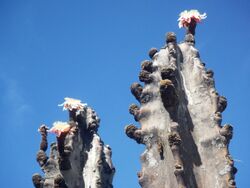Biology:Neoraimondia arequipensis
| Neoraimondia arequipensis | |
|---|---|

| |
| Scientific classification | |
| Kingdom: | Plantae |
| Clade: | Tracheophytes |
| Clade: | Angiosperms |
| Clade: | Eudicots |
| Order: | Caryophyllales |
| Family: | Cactaceae |
| Subfamily: | Cactoideae |
| Genus: | Neoraimondia |
| Species: | N. arequipensis
|
| Binomial name | |
| Neoraimondia arequipensis (Meyen) Backeb.[2]
| |
| Synonyms[2] | |
| |
Neoraimondia arequipensis, synonym Neoraimondia macrostibas, is a tree-like cactus (family Cactaceae) native to western Peru.[2] It was first described in 1835 as Cereus arequipensis.[2][3]
Description
Neoraimondia arequipensis grows like a shrub, branches at the base and does not form a stem. The massive, upright shoots reach heights of growth of up to 10 meters with a diameter of up to 40 centimeters. There are 5 to 8 ribs. The cone-like, conspicuous areoles are up to 5 centimeters long. Of the up to 7 thorns per areole, some are up to 25 centimeters long.
The species has the largest areoles of any cactus; up to 10 cm (4 in) long by less than half as wide. From these emerge spines up to 24 cm (9.4 in) long.[4] It is also the source of one ingredient in the psychoactive beverage cimora.[5][6]
The greenish-white to pink-red flowers reach a diameter of up to 3 centimeters. Their pericarpel is studded with short hairs and sometimes with inconspicuous spines. The spherical fruits are purple and have a diameter of up to 7 centimeters. They are covered with brownish, felt-like areoles that have short thorns.
Distribution
Neoraimondia arequipensis subsp. roseiflora (Werdermann & Backeberg) Ostolaza (1998) is an endemic cactus in Peru and is widely distributed throughout the Andes, in the Departments of Ancash, Lima and Ica, being the Department of Lima where its presence is verified in almost all the valleys with a high number of individuals.
They survive with very little water, only with the sea breeze on the coastal hills or the drizzle, a phenomenon that originates with the El Niño current.
Taxonomy
The first description as Cereus arequipensis was published in 1833 by Franz Julius Ferdinand Meyen. Curt Backeberg placed them in the genus Neoraimondia in 1937.
In the IUCN Red List of Threatened Species, the species is listed as "Least Concern (LC)".[1]
References
- ↑ 1.0 1.1 "The IUCN Red List of Threatened Species". IUCN Red List of Threatened Species. 2011-05-07. https://apiv3.iucnredlist.org/api/v3/taxonredirect/151758. Retrieved 2023-08-13.
- ↑ 2.0 2.1 2.2 2.3 "Neoraimondia arequipensis (Meyen) Backeb.". Plants of the World Online. Royal Botanic Gardens, Kew. https://powo.science.kew.org/taxon/urn:lsid:ipni.org:names:136142-1.
- ↑ "Neoraimondia arequipensis (Meyen) Backeb.". The International Plant Names Index. https://www.ipni.org/n/136142-1.
- ↑ Britton, Nathan L.; Rose, Joseph N.. The Cactaceae - Volume 2 (1963 reprint ed.). New York: Dover Pubs. p. 182.
- ↑ Cruz Sánchez, Guillermo (1945). "Farmacología de la Isotoma Longiflorum". Revista Peruana de Medicina Experimental y Salud Publica 4 (4): 284–318. ISSN 1726-4634. http://www.scielo.org.pe/scielo.php?script=sci_abstract&pid=S1726-46341945000400003&lng=es&nrm=iso&tlng=es.
- ↑ Schultes, Richard Evans (1981). "Iconography of New World Plant Hallucinogens". Arnoldia 41: 80–125.
Wikidata ☰ {{{from}}} entry
 |


